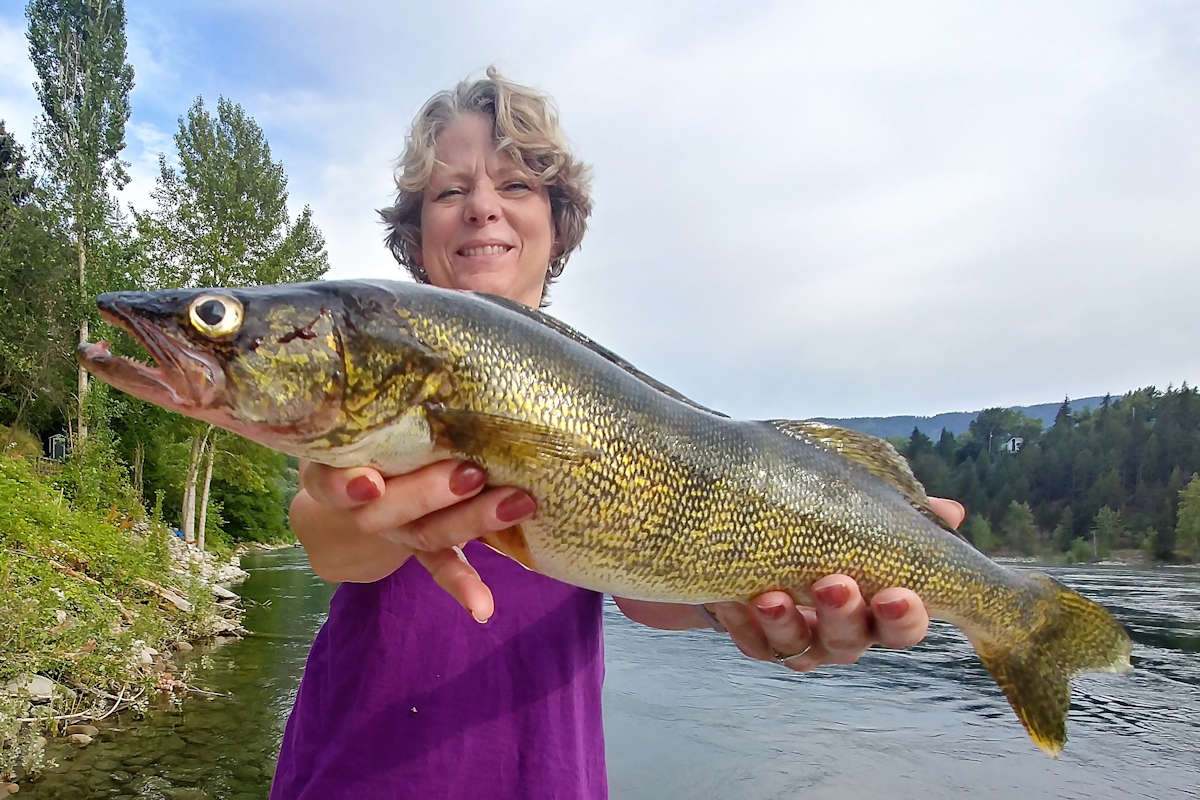By Jim Bailey
Targeting walleye:
The 50-km stretch of the Columbia River near Trail, B.C. may be the best, least fished rainbow trout stream in North America.
Yet, here I am tucked inside the elbow of a 60-foot seam targeting walleye.
The rushing water rolls into a large back eddy. On the horizon, the summer sun slips behind Red Mountain, as frantic caddis hatches dance in the ebbing light, beckoning rainbows from the depths.
I ignore the tantalizing dry-fly prospects and cast an egg-sucking leech pattern into the rapid and watch the sink line run out. I give three or four more strips for luck.
The current takes the line into the seam, and I let it run out and settle before making a slow retrieve, with the odd twitch, in expectation of a subtle take.
Fly fishing for walleye:
A 6-weight fly rod with a fast sink line and a short 4-to 6-foot leader is sufficient for most walleye, and I generally tie on a swivel and attach about 14 inches of #2 tippet due to their sharp teeth.
Fly fishing for walleye from shore is relatively simple. Find a back eddy or deep water, somewhere that looks fishy and start casting.
I’ve never targeted walleye from a boat, but local guide Graham Cloutier of Chillbilly Charters is an expert. He uses spin casters with hefty weights and worm harnesses to target walleye in up to 60 feet, but also throws flies at walleye when the opportunity presents itself.
There is a subtlety in the takes that often go unperceived. I give the rod tip a lift every couple strips to check for resistance. Usually, the line tightens briefly, I bring the tip up sharply, and the rod jumps. I give a quick set and watch the line as it moves intently away.
It does not take long to figure out whether the walleye has broad shoulders or not. My biggest walleye on the river was 32-inches and it fought like a bull, its nose in the ground, stealing line slowly but relentlessly for so long, I thought it would take me into my backing.
When I first moved to Trail in 1999, I was unfamiliar with the walleye and its big, vacant eyes, coarse scales, and dagger-sharp teeth. One of my first trips down to the river yielded a 26-inch beast, but unfamiliar and frankly horrified, I grabbed my forceps, surgically removed the fly from its mouth and kicked it back into the river.
I’ve learned a lot since then.
Rapid reproduction
Walleye are prolific spawners. One to six males follow females to their spawning beds, where the female can lay over 60,000 eggs for the males to fertilize.
The robust numbers are the reason there is no limit on walleye in the Columbia River south of the Canadian border, and a generous 16 per day north of the U.S.-Canada border.
They generally spawn in slack water and in the Columbia River an area known as Robson Reach north of Castlegar is prime benthic spawning habitat.
Almost immediately upon hatching, walleye larvae feed on zooplankton, and within the first year they switch to aquatic insects that crawl along the bottom, such as mayfly and stonefly nymphs, and other invertebrates.
By the time they are about eight centimetres they will feast on minnows, and even smaller walleye. They can eat other species half their size, they never stop growing and the resilient ones can live up to 20 years.
The invasive species:
Few fish species are less attractive or more glutinous than the walleye, a cross between a northern pike and a northern pikeminnow.
Walleye are an invasive species on the Columbia River, a prolific predator that can impact the population of native species like kokanee salmon, white fish and rainbow trout, as well as the Columbia’s endangered white sturgeon.
First introduced into Lake Roosevelt, a reservoir of the Columbia, in the 50s, the walleye fishery was burgeoning by the 60s.
Walleye tend to aggregate when and where there is the possibility of an easy meal. They in part made a huge impact on a kokanee hatchery program on Roosevelt Lake in 1999.
Studies at Sherman Creek show that walleye decimated 15 per cent of kokanee fry within 41 days of being released from the hatchery that year, and almost 10 per cent of a kokanee fry and 7.5 per cent of rainbow fry during a 2000 stocking effort.
There have been few if any studies on Columbia River walleye in BC despite a long history of sturgeon decline. Yet, Eastern Washington University is currently conducting a study on walleye and the invasive species’ impact on White Sturgeon larvae this summer. The study will focus on the hypothesis that walleye do aggregate near sturgeon pre-spawn, peak spawn, and post-spawn and feed on larvae voraciously.
If a higher number of larval white sturgeon are found in walleye stomachs during the spawning season, it could suggest that a shift in feeding behaviour does occur, indicating the walleye do move to the Upper Columbia arm of Lake Roosevelt and across the BC border where the larval drifts occur.
A thriving alien delicacy:
Walleye are comparable to ling cod, and is wonderful poached in white wine, or breaded and pan fried and served with a slice of lemon and homemade tartar sauce, or drowned in beer batter and plunged into the deep frier and served on a taco with fresh slaw and a cold beer.
The limit for the invasive species is 16 per day per person in hopes of keeping their numbers in check.
BC Fishing regulations often make retention limits very muddy when peering into the pool. On many lakes and streams the retention limit for pike, bass, perch or walleye is zero. The rationale is they don’t want to encourage the illegal introduction of alien species.
The Columbia and Pend d’Oreille Rivers are exempt and have high retention limits of alien or invasive species. On the Pend d’Oreille, a tributary of the Columbia, there is no limit on bass, walleye, yellow perch and northern pike.
On the Columbia the retention limits are 16 for walleye, and unlimited for bass and pike.
The daily limit for rainbow trout on the river is two.
Just a reminder. According to the BC Fishing Regulations, it is illegal to move fish between waterways in B.C.; perpetrators can face fines of up to $100,000 for first-time offences, and/or a prison term of up to 12 months for a second-time offence.
It is also illegal to have live fish in your possession in the wild and, in most parts of B.C., the use of live or dead finfish for bait is strictly prohibited.







